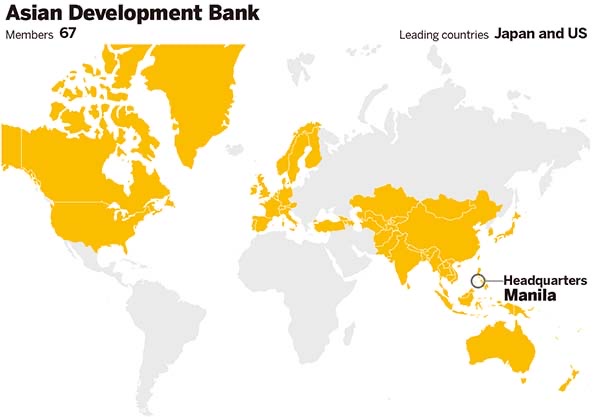CONTENTS
- Digital India Mission
- Asian Development Bank
Digital India Mission
Context:
2024 marks the completion of nine years of Digital India programme.
Relevance:
GS-III: Science and Technology, GS-II: Social Justice (Welfare Schemes)
Dimensions of the Article:
- What is Digital India Mission?
- Vision and Vision area of Digital India
- Challenges and the Way Forward in India’s Digital Landscape
What is Digital India Mission?
- Digital India is a flagship programme of the Government of India with a vision to transform India into a digitally empowered society and knowledge economy.
- The Government of India approved the NeGP, comprising of 27 Mission Mode Projects (MMPs) and 8 components in 2006, developed by Department of information & Technology and Department of Administrative Reforms and Public Grievances.
- The 11th report of the Second Administrative Reforms Commission (2008), titled “Promoting e-Governance – The Smart Way Forward” called for government to expand its e-governance capacity.
- In 2015 the Union Cabinet gave its approval for the Approach and Key Components of eKranti -National e-Governance Plan (NeGP) 2.0.
- This programme provided for the establishment of Common Service Centres for citizens to have an easy access to government services through various applications.

Vision and Vision area of Digital India
The vision of Digital India programme is to transform India into a digitally empowered society and knowledge economy.
The Digital India programme is centred on three key vision areas:
Digital Infrastructure as a Core Utility to Every Citizen
- Availability of high speed internet as a core utility for delivery of services to citizens
- Cradle to grave digital identity that is unique, lifelong, online and authenticable to every citizen
- Mobile phone & bank account enabling citizen participation in digital & financial space
- Easy access to a Common Service Centre
- Shareable private space on a public cloud
- Safe and secure cyber-space
Governance & Services on Demand
- Seamlessly integrated services across departments or jurisdictions
- Availability of services in real time from online & mobile platforms
- All citizen entitlements to be portable and available on the cloud
- Digitally transformed services for improving ease of doing business
- Making financial transactions electronic & cashless
- Leveraging Geospatial Information Systems (GIS) for decision support systems & development
Digital Empowerment of Citizens
- Universal digital literacy
- Universally accessible digital resources
- Availability of digital resources / services in Indian languages
- Collaborative digital platforms for participative governance
- Citizens not required to physically submit Govt. documents / certificates
Challenges and the Way Forward in India’s Digital Landscape
Digital Divide:
- Challenges: As of 2021, India’s internet penetration was 47%, with rural areas significantly lower at 32% compared to 67% in urban areas.
- Way Forward: Implement initiatives like the PM-WANI scheme to establish 2 million public Wi-Fi hotspots by 2024, aiming to bridge the digital gap.
Infrastructure Gaps:
- Challenges: Despite BharatNet’s progress, only 1.7 lakh out of 2.5 lakh gram panchayats were connected by optical fiber by 2021.
- Way Forward: Invest in 5G infrastructure to achieve 40% population coverage by 2025, addressing rural connectivity challenges effectively.
Digital Literacy:
- Challenges: Only 34% of India’s population is digitally literate as per a 2021 Internet and Mobile Association of India IAMAI report.
- Way Forward: Scale up Pradhan Mantri Gramin Digital Saksharta Abhiyan PMGDISHA to train 60 million rural households by 2023. Integrate digital literacy into school curricula to increase literacy to 50% by 2025.
Cybersecurity and Data Privacy Concerns:
- Challenges: India faced over 1.1 million cybersecurity incidents in 2020, highlighting significant vulnerabilities.
- Way Forward: Implement the National Cyber Security Strategy to reduce cybercrime incidents by 50% by 2026. Enforce the India Digital Personal Data Protection Act 2023 to enhance privacy safeguards.
E-Governance Challenges:
- Challenges: Digital identity verification and service delivery issues persist in remote areas despite advancements in e-governance.
- Way Forward: Introduce a unified digital identity system for all government services by 2024. Expand UMANG app services from 1,251 to 2,500 by 2025 for enhanced accessibility.
Skills Gap:
- Challenges: The NASSCOM FutureSkills report indicates a significant skills gap, with 20% of tech professionals lacking essential digital skills.
- Way Forward: Launch a national digital skills program to upskill professionals in emerging technologies, aiming to meet the demand for 30 million digitally skilled professionals by 2026.
Asian Development Bank
Context:
Recently, Government of India and the Asian Development Bank (ADB) signed a USD 170 million policy-based loan to strengthen India’s health system preparedness and response capacity to future pandemics.
Relevance:
GS II- Inter Groupings
Dimensions of the Article:
- About Asian Development Bank (ADB)
About Asian Development Bank (ADB):

- The Asian Development Bank (ADB) is a regional development bank established on 19 December 1966 to promote social and economic development in Asia.
- It is headquartered in the city of Mandaluyong, Metro Manila, Philippines.
- The ADB was modelled closely on the World Bank and an official United Nations Observer.
- Japan holds the largest proportion of shares in ADB followed by the USA, and it has a weighted voting system where votes are distributed in proportion with members’ capital subscriptions (just like the World Bank).
- The bank admits the members of the United Nations Economic and Social Commission for Asia and the Pacific (UNESCAP, formerly the Economic Commission for Asia and the Far East or ECAFE) and non-regional developed countries.
- ADB defines itself as a social development organization that is dedicated to reducing poverty in Asia and the Pacific through inclusive economic growth, environmentally sustainable growth, and regional integration.
- ADB aids in reducing poverty through investments in the form of loans, grants and information sharing (in infrastructure, health care services, financial and public administration systems), helping nations prepare for the impact of climate change or better manage their natural resources, as well as other areas.



